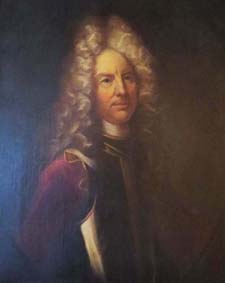Gabriel Du Quesne
Philosopher, Soldier & Honorary Marquis
c1684 - 1748


Marriage & Family
He had married Elizabeth née Bradshaigh, widow of Job Yate, on 28 August 1714 at St Peter le Poer, London. Elizabeth was baptised on 22 April 1685 at Wigan, the daughter of Sir Roger Bradshaigh of Haigh Hall, an ancient Lancashire family. Her first marriage, to Job Yate (1677-1711) took place in 1706, but he died 5 years later. There were five children of the union: William (1716-c1736); Thomas Roger(1718-1793), christened at St Mary's Church, Twickenham on 28 August; Henry (c1720-1742); Elizabeth (b1722) and Jane Ann (1724), born in Geneva.Du Quesne enjoyed the friendship of Henry Newman, Secretary of the SPCK, who endeavoured to care for the children of the impoverished Gabriel.
Another generous friend of the family was Anne, Lady Torrington the daughter of the Earl of Bradford and living at Richmond House, Twickenham. She was godmother to Du Quesne's daughter, Ann. It is recorded that there were three further children, but nothing is at present known of them, nor when Elizabeth died.
Going to live, modestly, at Teddington, he was said to be scraping a living by selling wine, oil and olives at Hampton Court. Despite this it was claimed that he was starving in 1740.
The Du Quesne Marquisate
For his outstanding naval services Gabriel's grandfather, Admiral Abraham Du Quesne (1610-1688), was presented with the Barony of Bouchet-Valgrand, near Etamples by Louis IV in 1681. In the following year Louis raised him to the rank of Marquis Du Quesne. In accordance with French custom this marquisate was linked with ownership of the estate: the title remained with the fief and, subject to application could be awarded to a later owner. When Abraham died the estate passed into other hands and in 1720 the title was re-registered in the name of a later owner.
Abraham's eldest son, Henry (1642-1722), married in 1683 in accordance with the marriage contract “between Henri Du Quesne, called Marquis, like his father”. For Henry the title was no more than a courtesy, in accordance with French custom.
Gabriel was born in 1684, during the life of his grandfather and so enjoyed the courtesy title “Marquis”, but it was no more than that. When he came to England, in 1709, he used his title for a number of years, possibly until 1722 when his father died. There was, however, no question of his son Thomas using the title.
His Will (PCC Prob11/759):
Du Quesne made his Will on 9 December 1747 and it was proved on 4 February 1747/8 (old style). He described himself as Gabriel Du Quesne Esq, of St James, Westminster having relinquished the use of his title as a Marquis.
The Will is brief. He left the sums of £10 to his son Thomas Roger and married daughter Anne French of the Isle of Wight for mourning rings, appointed Stephen Cabibel of the City of London, merchant sole executor and bequeathed him £400 for his trouble in paying debts and settling the estate. The remainder of his assets were to be divided equally between John Kelly Esq of the Inner Temple and Anna Maria Drake, spinster, of Knightsbridge.
Elizabeth, his wife, and daughter Elizabeth, had already died, the former in Newport, on the Isle of Wight in 1743. She had gone to live with her married daughter, Jane Ann (Husband John French), and is recorded as the housekeeper at Carisbrooke Castle between about 1735 and 1742.
Thomas Roger Du Quesne (1718-1793)
Thomas was christened at St Mary's Twickenham on 28 August 1718, son of Gabriel Marquis Du Quesne as described in the parish register. He enjoyed a more satisfactory life than his father.In 1729 he obtained a scholarship to Eton and, in 1738, to King's College, Cambridge. He was elected a Fellow in 1741 remaining so for 12 years. Ordained Deacon in 1744, he was, in 1753 presented to the Living of Honingham in Norfolk by the influence of a relative of his mother, Charles Townshend. Townshend also presented him with the living of East Tuddenham and, in need of a vicarage, an old manorial house known as Berry's Hall. Here he spent the remainder of his life, a bachelor living in increasing comfort by the acquisition of various stipendiary positions: the rectory of Scole, Prebend of Ely and Lichfield, and Canon Chancellor of St David's.
A memorial recording his life was erected in the chancel of East Tuddenham church.
Further reading
W K Lowther Clark, 18th Century Piety, III, Henry Newman and the Du Quesnes, SPCK, 1944John Beresford, Mr Du Quesne and other Essays, Oxford University Press, 1932




